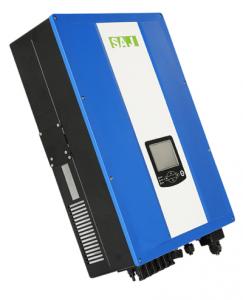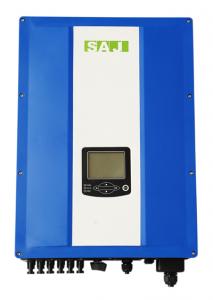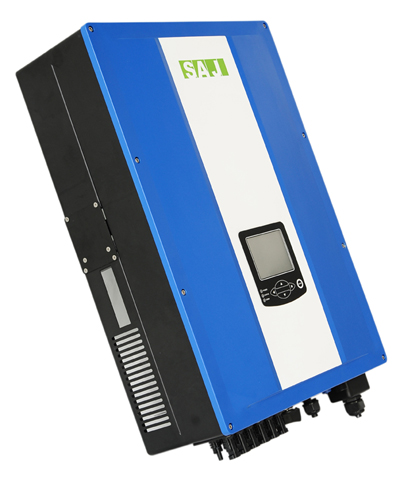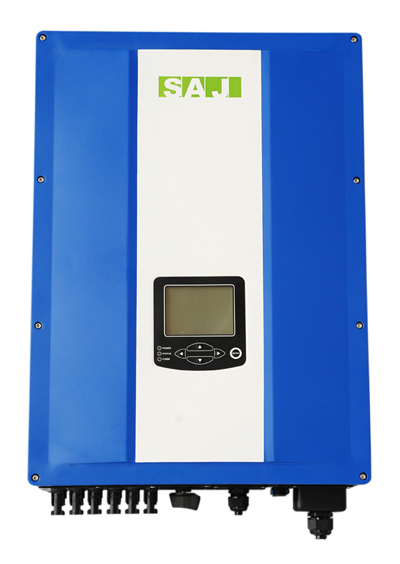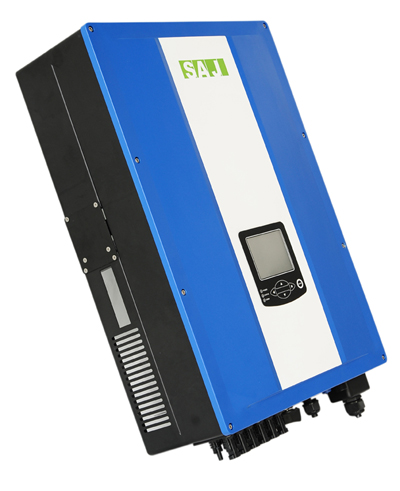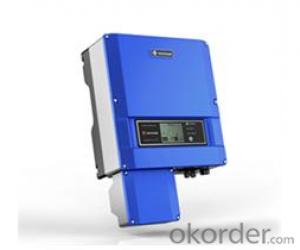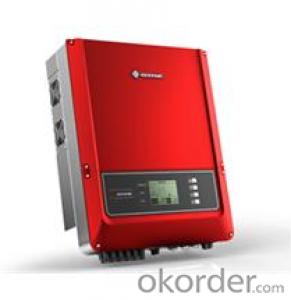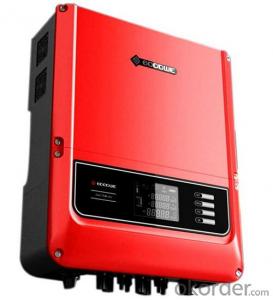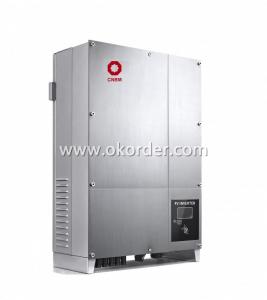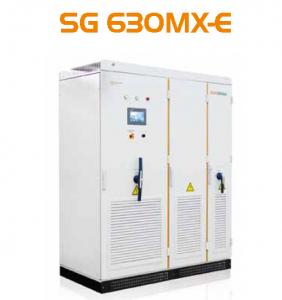15kW Solar Inverter On Grid Suntrio-TL6K with 2MPPT
- Loading Port:
- Guangzhou
- Payment Terms:
- TT OR LC
- Min Order Qty:
- 1 watt
- Supply Capability:
- 3000 watt/month
OKorder Service Pledge
OKorder Financial Service
You Might Also Like
Suntrio-TL5K/6K/8K/10K PV inverters are transformerless inverters with efficiency of up to 97.5%. Multi-MPPT inputs provides higher flexibility for the project installation. Stainless steel housing and IP65 protection guarantee use both indoor and outdoor for long. The series inverters are ideally suited for medium and commercial PV projects of up to MW range.
1. Leading technology
· Max. efficiency 98.0%
• MPPT accuracy up to 99.9% efficiency
• Compliant with VDE-AR-N 4105
2. User-friendly
• 5 inch LCD display with comprehensive information
• Embedded webserver monitoring
• Easy installation
3. Flexible
• Multi-country configuration
• RS485 / Ethernet / Wi-Fi communication
• Wide range of DC input voltage
• IP65 for indoor and outdoor
4. Certificates: TUV,SAA,G83,ISO9001,ISO14001,etc.

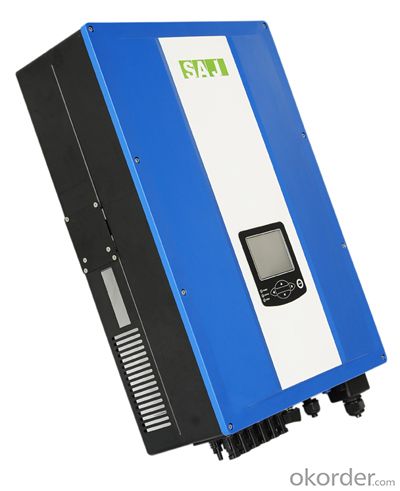
FAQ
1. How long will my inquiry get response?
Your inquiry related to our products or prices will be replied within 24 hours.
2. Can I get professional service and suggestion?
Well-trained and experienced staffs to answer all your questions in fluent English.
3. Do you accept OEM or customized design?
OEM & ODM, any your customized lightings we can help you to design and put into product.
4. What if I need specific design?
Distributorship are offered for your unique design and some our current models.
- Q: Can a solar inverter be used with different types of solar cell technologies?
- Yes, a solar inverter can be used with different types of solar cell technologies. Solar inverters are designed to convert the DC electricity generated by solar panels, regardless of the type of solar cell technology, into AC electricity that can be used to power homes and businesses. Therefore, whether it is monocrystalline, polycrystalline, thin-film, or any other solar cell technology, a solar inverter can efficiently convert the generated electricity into usable form.
- Q: How the output voltage of the PV inverter and the grid-connected voltage are determined
- supply through the cable to the battery. The use of household appliances connected to the power converter output can be used in the car a variety of electrical appliances. The available electrical appliances are: mobile phones, laptops, digital cameras, cameras, lights, electric razors, CD players, game consoles, handheld computers, power tools, car refrigerators and various tourism, camping, medical emergency appliances Wait.
- Q: Can a solar inverter be used for commercial-scale solar installations?
- Yes, a solar inverter can be used for commercial-scale solar installations. Solar inverters are essential components of any solar PV system, converting the DC electricity generated by solar panels into AC electricity suitable for commercial use. They are available in various sizes and capacities, allowing them to accommodate the power requirements of large-scale commercial installations. Additionally, advanced features like grid-tie functionality and monitoring capabilities make solar inverters suitable for integration into commercial-scale solar installations.
- Q: What is the role of a solar inverter in power factor correction?
- The role of a solar inverter in power factor correction is to convert the direct current (DC) generated by the solar panels into alternating current (AC) that can be used by the electrical grid. In doing so, the solar inverter ensures that the AC power being fed into the grid has a power factor close to unity, which means it is efficient and does not cause any unnecessary strain on the electrical system. This helps to improve the overall power quality and efficiency of the solar energy system.
- Q: Can a solar inverter be monitored remotely?
- Yes, a solar inverter can be monitored remotely. Many modern solar inverters have built-in monitoring capabilities that allow users to track the performance and energy production of their solar system from a remote location. This can be done through software applications or web-based platforms that provide real-time data and analytics, enabling users to monitor the system's efficiency, diagnose issues, and optimize its performance without physically being present at the location of the inverter.
- Q: How does the temperature affect the performance of a solar inverter?
- The temperature can significantly affect the performance of a solar inverter. As the temperature increases, the efficiency of the inverter decreases. This is because the internal components of the inverter can overheat, leading to a decrease in power conversion efficiency. Additionally, high temperatures can also cause voltage drops and create thermal stress on the components, which can further impact the performance and longevity of the inverter. Therefore, it is crucial to consider temperature management and cooling mechanisms to ensure optimal performance and reliability of a solar inverter.
- Q: What is the difference between a grid-tied and off-grid solar inverter?
- A grid-tied solar inverter is designed to work with the traditional utility grid. It converts the DC power generated by solar panels into AC power that can be used in the home or business, and any excess power can be fed back into the grid. In contrast, an off-grid solar inverter is used in standalone systems, where there is no connection to the utility grid. It converts the DC power generated by solar panels into AC power for immediate use or for storage in batteries, ensuring a reliable power supply in isolated areas or during power outages.
- Q: How do you calculate the maximum power point tracking range for a solar inverter?
- To calculate the maximum power point tracking (MPPT) range for a solar inverter, you need to determine the voltage and current range within which the solar panels can produce the maximum power output. This involves analyzing the voltage-current (V-I) curve of the solar panels under different irradiance and temperature conditions. By continuously monitoring the output of the solar panels, the MPPT algorithm in the inverter adjusts the operating point to match the maximum power point, ensuring optimal energy conversion. Therefore, the MPPT range is determined by the variations in irradiance, temperature, and the characteristics of the solar panels, and it can be calculated through experimentation or by referring to the manufacturer's specifications.
- Q: Can a solar inverter be used with a solar-powered telecommunications system?
- Yes, a solar inverter can be used with a solar-powered telecommunications system. A solar inverter is responsible for converting the direct current (DC) generated by solar panels into alternating current (AC) that can be used to power electrical devices. In the case of a solar-powered telecommunications system, the solar inverter would convert the DC power generated by the solar panels into AC power to effectively operate the telecommunication equipment.
- Q: What is the maximum power capacity of a solar inverter?
- The maximum power capacity of a solar inverter can vary depending on its specific model and design. However, typical residential solar inverters have a power capacity range of 1-10 kilowatts (kW), while commercial and industrial inverters can range from 10 kW to several megawatts (MW).
Send your message to us
15kW Solar Inverter On Grid Suntrio-TL6K with 2MPPT
- Loading Port:
- Guangzhou
- Payment Terms:
- TT OR LC
- Min Order Qty:
- 1 watt
- Supply Capability:
- 3000 watt/month
OKorder Service Pledge
OKorder Financial Service
Similar products
Hot products
Hot Searches
Related keywords
